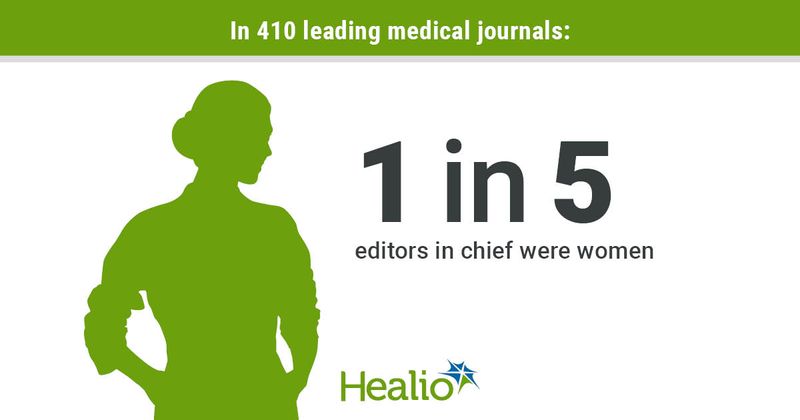Women 'significantly underrepresented' in medical journal editor positions
Among 410 leading medical journals, just 21% had a woman as editor in chief, according to findings published in JAMA Network Open.
“Evidence on the gender gap in academia has been mounting over the past few years, and the gendered impact of COVID-19 may have exacerbated longstanding gender inequalities,” Ana-Catarina Pinho-Gomes, DPhil, an honorary research fellow at The George Institute for Global Health in the U.K., told Healio Primary Care. “These have been highlighted at all stages of the academic ladder and in many fronts, from authorship of papers to editorial boards, medical conferences and leadership roles. This is true for academic and clinical medicine and across most medical specialties.”

Despite the evidence, Pinho-Gomes said “there has been hardly any change because those in a position of power and hence able to influence policy and make decisions are typically men who benefit from maintaining the status quo.”
Pinho-Gomes and colleagues conducted a cross-sectional study to assess gender distribution among editors in chief at the top 10 international medical journals for 41 specialty categories, encompassing 410 journals and 444 editor positions. Twenty-nine journals had more than one editor in chief.

The researchers determined gender representation using information available on each journal’s website as of April. Gender identity was determined by the pronouns used in the editor’s biography. When gender was not clear using public information, the researchers contacted the journal’s editorial office directly for clarification.
Disparities clearly evident
Overall, women represented only about one in five editors in chief, according to the researchers. Representation varied from 0% to 82% between the specialty categories. There were no women editors in chief within the categories of dentistry, oral surgery and medicine; allergy; psychiatry; anesthesiology; and ophthalmology. Only three categories — primary health care (seven of 10), microbiology (10 of 15) and genetics and heredity (nine of 11) — had more editors in chief who were women than men. Also, only one category — general and internal medicine — had equal gender representation in the editor-in-chief role. In 27 of the 41 categories, women represented less than one-third of editors in chief. Women were even underrepresented in journals on women’s health, accounting for only 54 of 132 editor-in-chief positions (41%) in 2019.
This unequal representation on editorial boards does not match the gradual increase in women’s representation in medicine over the past 60 years, according to Pinho-Gomes and colleagues.
While this study did not address whether representation in the editor-in-chief position impacts the content in the journals, other research has shown that women are more likely to promote other women in editorial boards and review panels, Pinho-Gomes said.
“Further research is warranted in this area. Editors in chief don’t make decisions alone and the gender of the author should not influence the likelihood of a paper being accepted, which should depend on the merit of the paper,” she said. “The question is more fundamental: do women have the opportunity to conduct high-quality research or are those opportunities snatched by men who can make those decisions?”
Several strategies can be implemented to improve representation in editorial boards such as gender quotas and raising awareness about gender inequalities, according to Pinho-Gomes.
“But we cannot overlook the fact that finding a gender gap at the top of the pyramid cannot be addressed by action at the top. This gender gap is fueled by gender gaps across the hierarchy,” Pinho-Gomes said. “Unless women are fairly represented at junior and middle grades, there will be no pool of women from which to select editors in chief and senior leaders, in general. So, we need to create an environment and culture (by means of women-friendly policies, mentoring, etc.) that allows women to thrive.”
‘Women leaders promote diversity’
In a related editorial, Elizabeth A. Jacobs, MD, MAPP, vice president for research at Maine Medical Center Research Institute and interim director of the Center for Outcomes Research and Evaluation, Ishani Ganguli, MD, MPH, an assistant professor at Harvard Medical School and Brigham and Women’s Hospital, and Sharon K. Inouye, MD, MPH, director of the Aging Brain Center at the Hinda and Arthur Marcus Institute for Aging Research in Boston, commented on representation in medical academia as previous editors of journals themselves. They postulated that increasing representation in editorial roles may benefit academia in several ways.
“We know that women leaders promote diversity in the workplace overall, and female editors in chief may bring more women and other underrepresented groups on as editors, board members and staff members,” they wrote. “Female leaders are also more likely to promote the publication of diverse voices and pull from a more diverse pool for invited editorials.”
Jacobs, Ganguli and Inouye added that “as three female journal editors who were fortunate to be asked and said yes to being editors, we believe it is important to look further upstream by increasing the number of women who are offered these roles or, if there is a formal application process, by encouraging women to apply.”
References:
Jacobs EA, et al. JAMA Netw Open. 2021;doi:10.1001/jamanetworkopen.2021.23364.
Pinho-Gomes AC, et al. JAMA Netw Open. 2021;doi:10.1001/jamanetworkopen.2021.23026.
